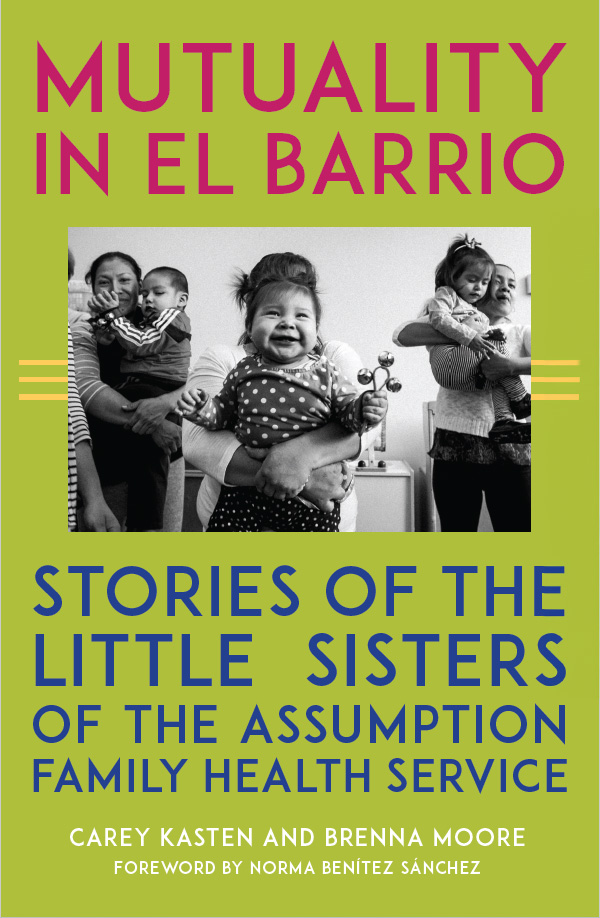Whether she’s exploring the life and legacy of a feminist sex educator (The Disappearance of Shere Hite) or the right-to-die legal battles surrounding Terri Schiavo (Between Life & Death), a common thread binds together many of the films she’s produced.
“They each unmask underlying power structures in society through deeply personal narratives, and question how we can do better to create a more equal and more just world,” said Ferdinando, a 2004 Fordham graduate and the executive producer of NBC News Studios.
She began working on her latest film—The Sing Sing Chronicles—in 2016. That’s when she visited Jon-Adrian “JJ” Velazquez at the maximum-security Sing Sing Correctional Facility, about 30 miles north of Midtown Manhattan, where he’d been serving 25 years to life for a murder he didn’t commit.

“He was a father desperate to get home to his children, and even though there were many glaring issues in his case, he’d exhausted all of his appeals,” Ferdinando said. “I connected with JJ immediately, and it was clear there was an important story to tell.”
Eight years and more than 1,000 hours of archival footage later, The Sing Sing Chronicles—a four-part docuseries—is bringing that story to light. The series premiered at the DOC NYC film festival on November 16, and it aired on MSNBC the following weekend. (It’s available for streaming on NBC’s website.)
The Sing Sing Chronicles highlights the bond NBC News investigative producer Dan Slepian formed with Velazquez over two decades—an unlikely connection that led to the exoneration of six men who were wrongfully convicted, including Velazquez, who was granted clemency in 2021 and finally exonerated on September 30 of this year. The docuseries is built on more than 20 years of investigative reporting by Slepian, who also recently authored a book recounting the experience.
As showrunner and executive producer of the series, Ferdinando said she’s extremely proud to be a part of a project detailing the complications of the criminal legal system and how a wrongful conviction can impact generations.
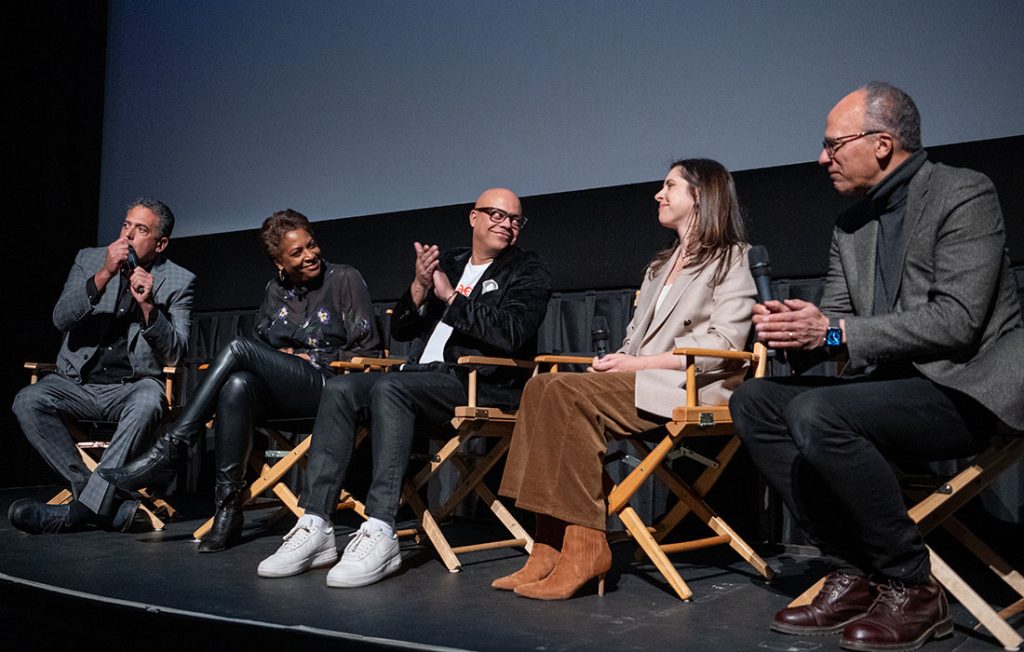
Launching a Media Career at WFUV
The award-winning journalist and filmmaker credits her success to the principles of journalism she learned as an undergraduate at Fordham, where she double majored in communication and media studies and Spanish language and literature. While completing her studies, she worked as an anchor, producer, reporter, and eventually news manager at WFUV, Fordham’s public media station.
“That radio station changed my life,” said the Staten Island native who chose Fordham after becoming familiar with the Lincoln Center campus while attending Fiorello H. LaGuardia High School of Music & Art and Performing Arts.
She did her first news broadcasts on WFUV shows Mixed Bag with 1967 Fordham grad Pete Fornatale and Vin Scelsa’s Idiot’s Delight, where she continued working five years after graduating.
With 20 years under her belt at NBC, Ferdinando recently returned to the University for “Fordham to the Frontlines: Alumni Journeys in News & Media.” The event, sponsored by the Career Center, featured several other successful grads and brought them together with students—an experience she described as “really heartening.”
“Career paths are unpredictable,” Ferdinando said. “If you don’t put yourself out there and say what you want to be doing, it’s hard to bring that to fruition. We really encouraged them to hone in on what they want to be doing and go after it.”
—Erica Scalise, FCRH ’20
They are: Marcel Chotkowski LaFollette’s Writing for Their Lives: America’s Pioneering Female Science Journalists (MIT Press, 2023); Santi Elijah Holley’s An Amerikan Family: The Shakurs and the Nation They Created (Mariner, 2024); Jane Ferguson’s No Ordinary Assignment: A Memoir (Mariner, 2023); Alan Philps’, The Red Hotel: Moscow 1941, the Metropol Hotel, and the Untold Story of Stalin’s Propaganda War (Pegasus Books, 2023); and Ari Shapiro’s The Best Strangers in the World: Stories from a Life Spent Listening (HarperOne, 2024).
Honoring a Storied Biographer
The Sperber Prize is given in honor of the late Ann M. Sperber, the author of Murrow: His Life and Times, the critically acclaimed biography of journalist Edward R. Murrow. One edition of that work was published by Fordham University Press, connecting the Sperber family to the university.
Through the generous support of Ann’s mother, Lisette, the $1,000 award was established to promote and encourage biographies and memoirs that focus on a media professional. It has been presented annually by Fordham University’s Department of Communication and Media Studies since 1999.
Professor of Communication and Media Studies Amy Aronson, Ph.D., director of the Sperber Prize, said the five finalists emerged from a pool of 48 titles considered for this year’s award. The winner will receive a $1,000 prize and be invited to keynote a public award ceremony held at Fordham’s Manhattan campus on November 11. The 6 p.m. event is free and open to the public.
“Our finalists take readers to profound encounters in less-traveled corners of the U.S. and the world,” Aronson said.
“They take us behind the front lines in dangerous conflict zones, reveal hidden stories of journalistic risk-taking, and into carefully researched biographies of public visionaries. All show us the vital importance of journalists and media voices in the world today.”
Previous winners of the Sperber Prize include Working by Robert Caro, Fire Shut Up in My Bones by Charles M. Blow, Cronkite by Douglas Brinkley, Lives of Margaret Fuller by John Matteson, Reporter by Seymour M. Hersh, The Publisher: Henry Luce and His American Century by Alan Brinkley, Avid Reader: A Life by Robert Gottlieb, and All Governments Lie! The Life and Times of Rebel Journalist I.F. Stone by Myra MacPherson. The most recent winner was The Newspaper Axis: Six Press Barons Who Enabled Hitler by Kathryn Olmsted.
The Finalists
LaFollette’s Writing for Their Lives profiles the first generation of women reporters who worked for Science Service, the first news organization in the country dedicated entirely to scientific journalism. LaFollette, author of Science on American Television, reveals that when the Service began in 1921, very few journalism organizations covered science at all, and those that did treated the subject cavalierly, putting any science hobbyist already on staff onto the rare stories deemed important enough to cover. They were all male hobbyists, of course. LaFollette explores how an aspiring and ambitious group of women writers confronted pervasive sexism and gender discrimination to create meaningful careers for themselves while developing a new and increasingly crucial journalistic beat.
Tupac Shakur, the late rapper who was killed in 1996 at the age of 25, was the “spark” for Holley’s An Amerikan Family, which explores the story of the Shakur family and their work for Black liberation in America. Some may be familiar with the rapper’s mother, Assata Shakur, the activist and writer for the Black Panther Party newsletter, living for three decades in Cuban exile, and many have come to know at least something about the iconic Tupac, her son. But Holley, a writer published in the Atlantic, New Republic, Economist, Guardian, and Washington Post, reveals that the branches of the Shakur family tree spread widely and ran deep into the underground of the civil rights struggle. The book is both a family genealogy and a larger story of one community’s struggle for racial justice, taking extreme, unconventional, and often perilous measures in that quest.
Ferguson’s No Ordinary Assignment is the memoir of a journalist who has covered nearly every war and humanitarian crisis of our time. A correspondent for PBS NewsHour, Ferguson was in Yemen for the Arab Spring. She managed to report from rebel-held Syria during its civil war despite the ban on foreign journalists. She was one of the last reporters to remain in Afghanistan when the Taliban claimed Kabul in 2021. Born and raised a Protestant in Northern Ireland during the Troubles, Ferguson is no stranger to sectarian violence or grave suffering. Her debut book chronicles the story of a remarkable woman coming into her own in the world’s most perilous and devastating circumstances as she dares to tell the hardest stories on earth as an act of justice.
Philps’ The Red Hotel takes readers inside the experiences of a cadre of American, British, and Australian journalists who reported from Moscow when Hitler invaded Russia in the summer of 1941. They were allowed to stay and report on the war at the Eastern front – as long as their stories were flattering to the Stalin regime. To help ensure this impossibly good press, they were billeted at the luxurious Metropol Hotel and supplied with bottomless vessels of vodka, lavish banquets, and young Russian secretaries and translators who were spies and sometimes prostitutes. Philps, who served as Moscow correspondent for Reuters and foreign editor of the Telegraph, reveals that while many of the translators conveyed Kremlin disinformation, some were dissidents who whispered to reporters about the truth of Soviet life and Stalin’s lies.
Shapiro’s The Best Strangers in the World takes readers around the globe to reveal the stories behind the sometimes heartwarming, sometimes heartbreaking narratives he reports to his listeners. The co-host of NPR’s All Things Considered, this book, his first, takes readers from Turkey to Ukraine to Indonesia to Northern Iraq; from drag shows in Florida to the corridors of power in Washington, DC; from war-torn locales in the Middle East and Africa as he follows the paths of refugees fleeing conflict to big cities and small towns. The result is a memoir-in-essays that is a love letter to journalism and a look at scores of individuals who not only refuse to break but also manage to confront life’s ugliness with beauty, meet horror with humor, and smile in the face of whatever might come next.
For additional information, questions, or press inquiries, please contact Amy Aronson at [email protected].
]]>Their focus is women and children who came to New York City from Mexico and found their way to the Little Sisters of the Assumption Family Health Service in East Harlem. There, they received holistic support that not only met their immediate needs but also empowered them to improve their circumstances, help others, and be leaders.
The agency “has been doing really effective work with diverse communities in a very complicated city and … developing power in a community that is typically disempowered,” said Fordham theology professor Brenna Moore, Ph.D. She and Carey Kasten, Ph.D., associate professor of Spanish at Fordham, are co-authors of Mutuality in El Barrio: Stories of the Little Sisters of the Assumption Family Health Service, out this month from Fordham University Press. A book launch takes place May 20.
Creating Pathways Out of Poverty
The Little Sisters of the Assumption, a Catholic order, founded its East Harlem agency in 1958 to create opportunities for families to escape poverty. The first executive director was Sister Margaret Leonard, GSS ’67, who codified the agency’s idea of mutuality.
It called for forming mutually enriching relationships with clients, “eschewing a binary framework of helper and helped in an effort to cocreate new realities in East Harlem that benefit all parties,” the book says.
That meant listening to migrants’ stories, offering mental and spiritual support, and unlocking their strengths over the long term. Sometimes it meant bringing them together so they could address common problems, like mold in their public housing. Former clients often return as volunteers and staffers or serve other New York City organizations in leadership roles.
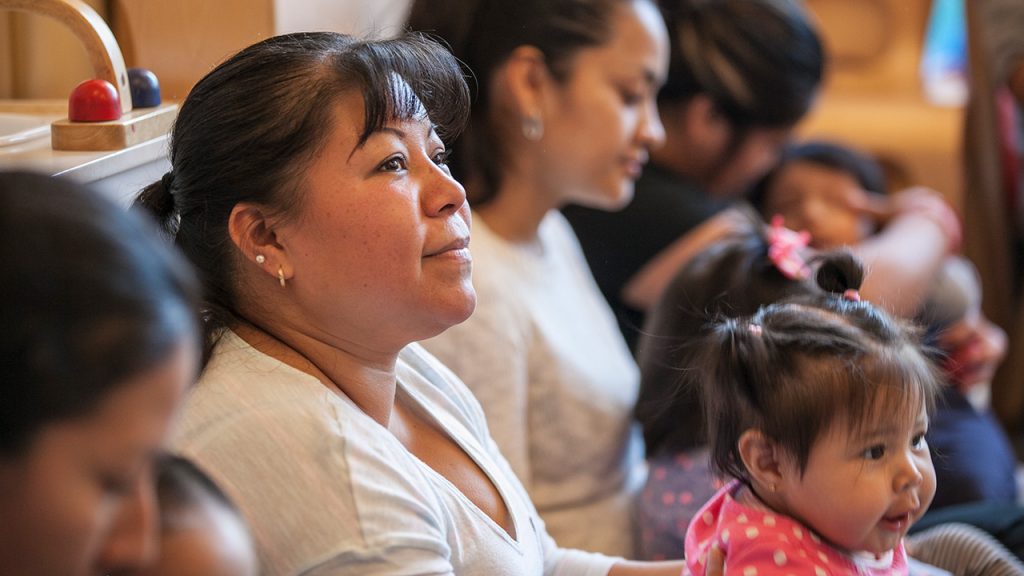
What mutuality is not, Kasten said, is “looking for immediate effects.”
“It’s willing to be in conversation with someone for years and understanding that sometimes it does take that long,” she said. “The things that people are asked to do when they come to this country don’t take just a week.”
Success Stories of Migrants
Eight Fordham students worked on the book project, gaining research experience by helping Moore and Kasten with interviewing migrants the agency served over the past few decades. The students included theology, Spanish, and communications majors, as well as students in the Graduate School of Social Service. Most migrants quoted in the book used pseudonyms.
The interviewees included Sonia, a onetime teenage mother whom the agency helped navigate prenatal care, develop parenting skills, and enroll in a pre-nursing degree program. The nuns also called upon her to provide nursing care to another Little Sisters client in her building.
And they stuck with her through crises—like being jailed on a false accusation from her child’s father, who had beaten her. The sisters prayed and sang hymns outside the jail overnight, giving her hope until charges were dropped the next day. She later moved to Florida, married, raised three children, and became head nurse in a hospital’s radiology department—at one point, overseeing the care of an ailing relative of Sister Margaret, who Sonia said is “like family.”
Another young mother, Yolanda, gained parenting skills through the agency and later joined its staff after earning her bachelor’s degree. “They began supporting me, motivating me,” she says in the book. In the words of another client: “They make you see what you don’t see in yourself.”
]]>This year’s batch of student films was among the strongest yet, said James Jennewein, a senior lecturer in the Department of Communication and Media Studies who runs the film and television undergraduate program.
“Over 40 original films were submitted, and there were so many high-quality stories being told, that this year it was especially hard to pick the 10 final winners,” he said. “The students never cease to inspire and amaze me with the level of artistry and storytelling skills they display.”
Fordham Film Fest Winners
Best In Festival: Ballet de la Poubelle by Honorah Brozio, a first-year student studying English with a minor in history
“I depicted a robot who feels left out of ballet and the robot represents every young dancer who feels like they aren’t good enough. Or any dancer who feels their body isn’t right for ballet, or their skin color isn’t right. I mostly wanted to highlight the feelings of a beginner dancer and the strength they have to have to keep going when it’s hard. Ballet is getting much better in terms of being inclusive but there’s a long history of discrimination. I have been dancing since I was very young. So this film was really a love letter to ballet while also acknowledging the struggles and exclusion many dancers experience.”
Best Cinematography: Jefa by Sebastian Giugovaz, a junior majoring in visual arts with a double minor in marketing and film and television
“Jefa was actually the final project for my Visual Thinking class. We were assigned to create a museum gallery with works from artists all over the world, representing a theme or concept of our choice. The short was named and inspired by a painting by Argentinian artist Xul Solar, which is named Jefa. It depicts a smirking cat-like figure made of geometric shapes and the word “Jefa”, (meaning boss or patroness) on its body. Whether it be anxiety, fear, or sadness, I wanted to make a piece that makes people feel. The idea behind my short is that sometimes, certain ideas or influences consume us and end up becoming ‘bosses’ of us.”
Best Editing: The Mistake by Matthias Lai, a junior majoring in journalism and digital design
“The film was inspired by my personal experience working with a Super 8 camera and having a lot of trouble getting the exposure and settings right, and having to rework it into something new. The entire film was shot and edited by me, so setting the camera up to frame and focus correctly was a challenge sometimes. The scene on the subway was one where I felt really awkward putting a camera on a tripod and filming myself in a subway car with other people, but I was able to overcome that anxiety and the shot turned out great, so I’m definitely glad I did. The biggest thing I want people to take away is that perfection isn’t as important as resilience, and it is important to lean on your friends and loved ones when you need help working through a crisis. I want to give my appreciation to everyone who helped me with the making of The Mistake, especially my mom, to whom the film is dedicated.”
Hearing from Alumni in Film and TV
STORY 2024 was hosted by Fordham’s New York Film and Television Alliance, a student-run organization that connects students to film and TV professionals to campus to give students real-world career insights.
The March 2 conference, which was overseen by Jennewein and Heidi C. Bordogna, an advanced lecturer in communications and media studies, also featured a panel of successful alumni who have gone into careers in the industry.
“I wouldn’t be on the career path I am if it weren’t for my teachers at Fordham,” said Lyra Tan, FCLC ’20, who now works as a TV literary coordinator at the Gersh Agency in Los Angeles. She spoke alongside fellow alumni Desiree Ewing, FCLC ’18, director of development at Goodbye Pictures, and Kayla Otero, FCLC ’21, drama development coordinator at CBS.
“It’s really great to have that Fordham community out here in LA,” Tan said of her ongoing professional relationships with Ewing and Otero. “We’re sort of joined together for life that way.”
]]>Auster joined the Department of Communications and Media Studies as a visiting assistant professor in 1996. He was appointed full professor in 2015, a position he held until he retired in 2020. He served as associate chair of the department at the Rose Hill campus from 2002 to 2003, and from 2003 to 2008 at the Lincoln Center campus.
Auster was born in Brooklyn, grew up in the Bronx, and graduated from City College in 1961. He earned a Ph.D. in history from S.U.N.Y. Stony Brook in 1981, and taught at Brooklyn College and SUNY College at New Paltz from 1982 to 1995 before joining the Fordham faculty.
At Fordham, he focused on film and television. He published several books, including American Film and Society Since 1945 (ABC-Clio, 2018), thirtysomething: Television, Women, Men and Work (Lexington Books, 2008), Turn On, Tune In… Television and Radio in the U.S.A. (Altair Publishing, 1994), How the War Was Remembered: Hollywood and Vietnam (Praeger, 1988), and Actresses and Suffragists: Women in the American Theater, 1890-1920 (Praeger, 1984).
In published papers and interviews, Auster weighed in on subjects as diverse as Seinfeld, Frank Sinatra, and the differences between spies in movies and in real life.
In 1999, he was instrumental in launching the Sperber Prize, which is given to authors of biographies and autobiographies of journalists. He served as chairman of the award committee for 20 years.
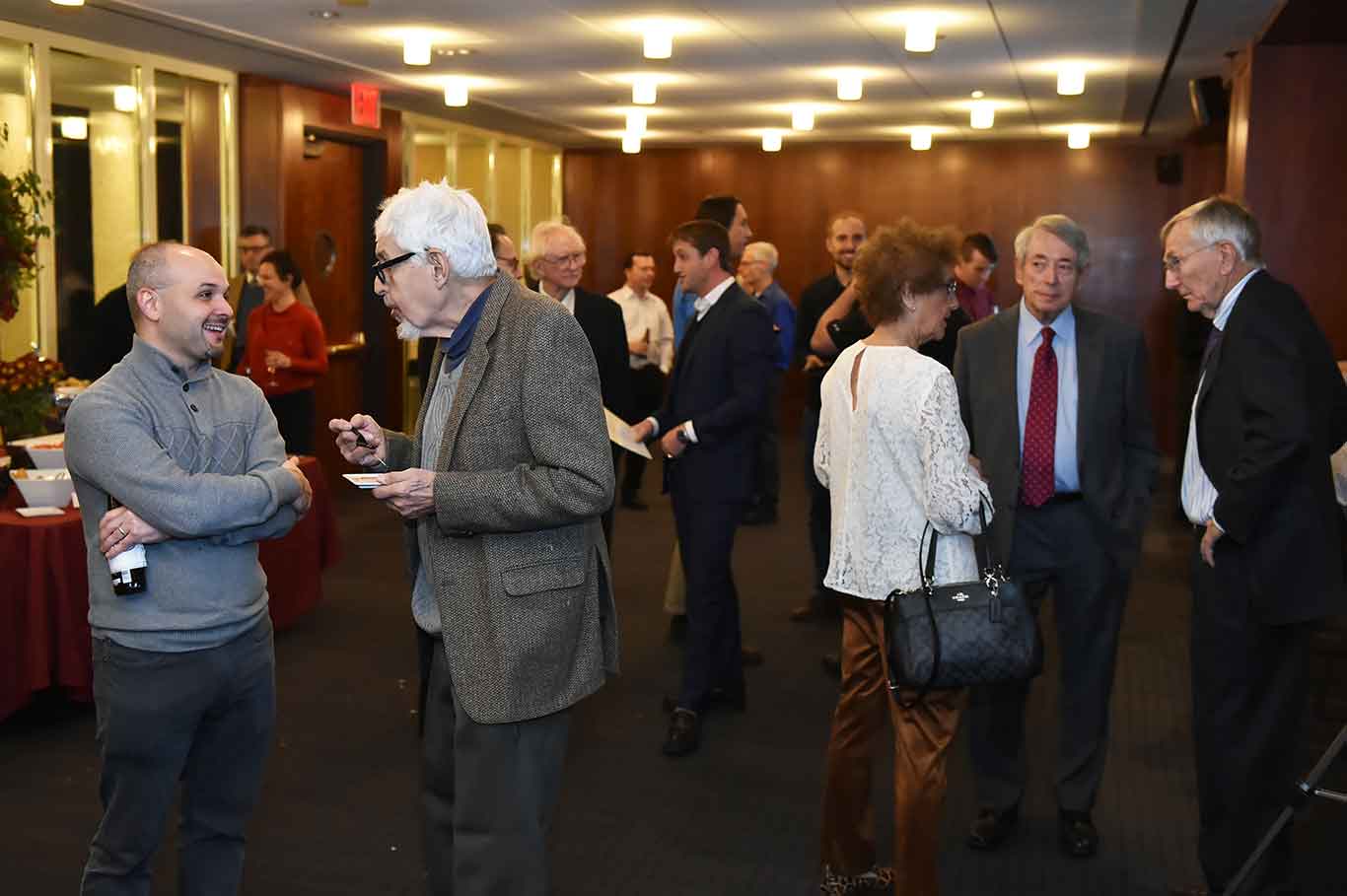
Brian Rose, Ph.D., a professor of communications who was director of the award following Auster, called him a treasured colleague whose good judgment and empathy were valued on both campuses.
“He brought a tremendous sense of intellectual energy and wide historical background to his media classes, which clearly engaged several generations of students at Fordham. Al’s warmth, generosity, and good humor will be sorely missed,” he said.
Jacqueline Reich, Ph.D., a former professor of communications and media studies who is now dean of the School of Communication and the Arts at Marist College, echoed Rose and said that Auster was fundamental in bringing the Sperber Prize to Fordham.
“His tireless advocacy and devotion to the program was so appreciated by the Sperber family in Anne Sperber’s memory,” she said, noting that he was a charming, gentleman and devoted teacher.
“One of my favorite quotes about him from a student evaluation was “‘I wish he was my grandpa.’”
In 2008, Auster organized, along with Paul Levinson, Ph.D., a conference dedicated to the HBO show The Sopranos. Levinson called him a “one-of-a-kind professor and human being who had a heart of gold, a smile that would light up a room, and an encyclopedic knowledge of everything he taught and talked about.” Levinson recalled asking Auster at the last minute to serve as an associate chair of the department at the Lincoln Center campus. Auster didn’t hesitate, he said.
“I would call him anytime I had an issue that needed discussion, and he always took the call, including at night and weekends. I knew I’d miss him when he retired, and I did. I know now I’ll miss him very much more,” he said.
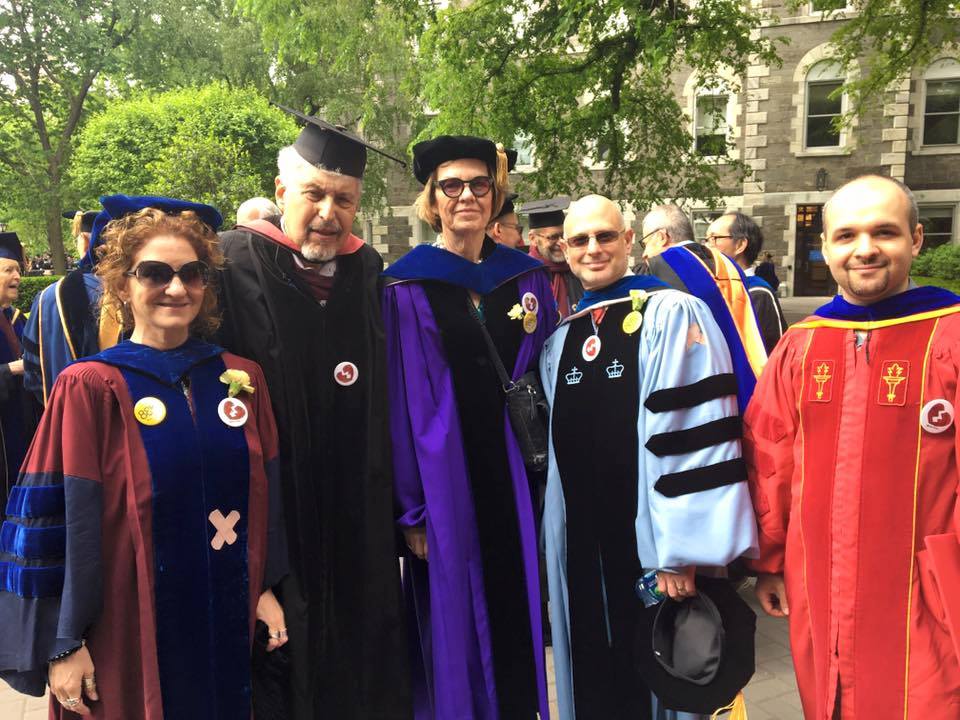
Photo courtesy of Gwyneth Jackaway, left
Thomas McCourt, Ph.D., a retired professor of communication and media studies, credited Auster with making him feel welcome when he first moved to New York City and was feeling out of his league.
“He had a wonderfully dry sense of humor and keen sense of the absurd. We spent hours and hours talking about jazz guitarists!” he said.
“I learned that a number of junior faculty in the department held an informal poll as to which senior colleague they would like to accompany on a cross-country road trip, and Al was the hands-down winner because he had so many great stories to tell. Al was the definition of a mensch.”
In 2016, Auster was recognized for his service at the University with a Bene Merenti medal. At the ceremony, he was lauded for being “a classic New Yorker, exemplifying the wit and heart of the city.” His citation praised him for his significant contribution to his field and to Fordham:
“Dr. Auster’s significant body of work details the history and impact of film and television on the American landscape. His wide-ranging interests are reflected in his many books and articles that have helped shape critical debates on how politics and media interact. In his studies of film and TV programming focusing on the Vietnam War, Dr. Auster has portrayed the complexities and contradictions of creators as activists in an industry typically focused on ratings and financial results,” the citation read.
“Through the years, numerous students have attested to the spirit of inquiry and openness that distinguishes his teaching. His classes provide a broad sense of context in which to address the fundamental questions of philosophy and ethics in past and present media. In both his life and work, Dr. Auster reflects the best aspects of Fordham and New York City.”
Auster’s wife Susan Hamovitch said he had recently begun working on a memoir that he called bubbenmeises, an intentionally misspelled Yiddish word that he defined as “Referring to a number of meanings: a false story, a story that is so eccentric as to be meaningless, or a story intended to divert from the real story. But are more than that because they have defined me [him]and my family.”
In the course of working on it, he’d realized that he was profoundly affected by the Holocaust, which resulted in the murder of his grandmother, aunts, and uncles. After graduating from City College, he worked in radio, for the Canadian Broadcasting Company and WBAI in New York City. It didn’t pay well enough though, she said, so he reluctantly went back to school to earn a Ph.D. in history. He would become a student of Hitler, Stalin, and the Jim Crow era of the Deep South, she said in remarks she delivered in a eulogy.
“His jam though, was to probe historical themes as contemporary American culture, mainly movies, portrayed them,” she said.
“How did film portray the Holocaust? The War in Vietnam? Jewish mores? For his graduate thesis, the question was, which of Hollywood’s stars were diehard suffragists?”
Auster’s life can be summed up as passionate and emotional, she said.
“He breathed the history of this country, from the Suffragist movement to race relations, from John Ford to Jerry Seinfeld, with pride, annoyance, rage and love, I suspect due to the bubbenmeises he’d lived through,” she said.
“He approached his end as he had his life, with kindness, discipline, and a sense of responsibility. He was an extraordinary man.”
Funeral services will be held Friday, April 1, at 11 a.m. at the Kerhonkson Synagogue in Kerhonkson, New York. The service will be streamed live on Zoom. His wife Susan Hamovich will be sitting shiva on Sunday, April 3 and a shiva minyan at 3 pm. Anyone who would like to share memories of professor Auster are asked to e-mail them to Susan at [email protected]. In lieu of flowers, the family asks that you consider making a donation to the Met Council on Housing and/or to Kolot Chayeinu.
]]>“Jonathon was a caring and compassionate educator who had the kind of multilayered career that one can only marvel at,” said Joseph M. McShane, S.J., president of Fordham, in an email to the University community. “He was thoughtful and creative, with a talent for drawing connections among disciplines.”
Appels taught in Fordham’s English, African and African American studies, anthropology, dance, history, communication and media studies, Middle East studies, theology, and visual arts departments, as well as the religious studies, comparative literature, and urban studies programs, from 1996 to 2002 and 2009 to 2021. He offered a colorful mix of courses, including “Madness and Literature” and “LGBT Arts and Spirituality: Mystics and Creators,” mostly at the Lincoln Center campus.
“His mind was eclectic and his education and curiosity was unmatched,” said Anne Fernald, Ph.D., professor of English and women, gender, and sexuality studies. “Endlessly curious, he always had a new story of the latest lecture or performance he had attended. He was a wonderful storyteller, with a rich laugh. He took me out to a vegan restaurant once, hoping to encourage me in more healthy habits. He was always cold and wandered the halls draped in wonderful scarves.”
Appels was a scholar, poet, musician, sculptor, and art critic who conducted research in 20 countries, largely in Europe; he was also a member of nine humanities associations.
“He had a very probing mind, and he was very good at connecting the dots between various disciplines and departments,” said his husband, David LaMarche. “He was a very animated and inquisitive person with strong opinions, but not rigid … a free spirit and sort of counterculture, since the time that we were born in, the early sixties, and a sensitive man who loved every branch of the arts.”
His First Love
But what most academics weren’t aware of, said his husband, was his love for dance.
“He loved teaching, but his first love was probably choreography,” LaMarche said.
Appels was a dancer and choreographer who founded his own dance company, Company Appels, in 1979. He performed across the country and the world, from the Whitney Museum of American Art in New York City to international stages in France, Germany, and Portugal. He choreographed modern dances for scores of performers, principally graduates of the Juilliard School, SUNY Purchase, and North Carolina School of the Arts. One of his favorite courses he taught at Fordham was part of the Ailey/Fordham BFA Program in Dance, run jointly with the Ailey School, said his husband. Even off stage at more casual venues, you could find him dancing.
“He loved disco dancing and he loved to dance, even into his sixties. If we ever went to a gala party or something like that, he’d always be on the dance floor, wild,” said LaMarche, a pianist who first met Appels at a dance class in San Francisco.
Appels’ passion for the arts was recognized worldwide. In 1998, he was awarded a Fulbright to teach modern dance at the National Dance Academy in Hungary. (He received another Fulbright to study the archives of a famous philosopher in Belgium in 1991.) In addition, he received an artist fellowship from the Foundation for Contemporary Performance Arts and a William Como Award from the New York Foundation for the Arts.
In a 2014 reflection, a Fordham alumnus praised Appels for showing him the beauty of dancing through his course called Lincoln Center Arts.
“I never considered dance to be very interesting, running the other way when friends would suggest going to the ballet … I now found myself discussing Balanchine, Paul Taylor, and Dance Theater of Harlem with anyone who would listen,” wrote Jason McDonald, who took the course as a Ph.D. student.
‘Now Keep That Big Smile’
Appels was a thoughtful instructor who wanted his students to take away something meaningful from his classes, said Thomas O’Donnell, Ph.D., co-chair of Fordham’s comparative literature program and associate professor of English and medieval studies.
“Jon really wanted his students to become exposed to very different ideas. He was a very curious and open-minded person, and it seemed that his lessons as a result were full of that same spirit,” O’Donnell said. “He cared about his students very deeply. For every student that I would talk to him about, he had some story or insight about their biography and who they were. He really wanted to get to know the students so he could help them better.”
He loved speaking with students about their work over the phone, said LaMarche. Before their calls ended, he left them with a unique message.
“He ended almost every phone call with a student by saying, ‘Now keep that big smile,’ which I thought was so cute,” LaMarche said, chuckling. “You can’t see someone smile over the phone, but he would always say that to them.”
An ‘Off-the-Grid Educational Experience’
Appels was born on May 17, 1954, in Falfurrias, Texas. His father, Robert C. Robinson, was a sales executive for oil companies and a financial planner; his mother, Patricia Robinson, neé Hosley, was an elementary school teacher. When he was a child, his family frequently moved because of the nature of his father’s job, said LaMarche. He lived in Nigeria and Libya and later settled in California.
“He was exposed to a lot of different cultures as a youngster … He got his B.A. at Western Washington University at a college called Fairhaven College, which was a very experimental educational institution at that time,” said LaMarche. “That started his off-the grid educational experience.”
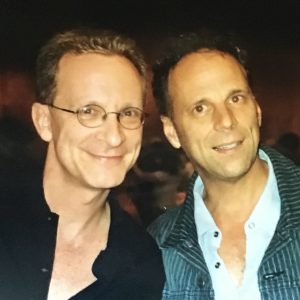
Appels earned a bachelor’s degree in art and society from Western Washington University, a master’s degree in music from Mills College, a master’s degree in poetry from Antioch University, and a Ph.D. in comparative literature from the City University of New York.
Outside of Fordham, he taught undergraduate and graduate students at Columbia University, Cornell University, Princeton University, Rutgers University, and his alma mater Western Washington University. He enjoyed yoga, pilates, gyrotonics, acupuncture, and other forms of Eastern medicine and healing. Instead of ironing his shirts and wearing a suit jacket like many professors, he preferred a loose and casual style, LaMarche said. He was a spiritual man who loved nature, especially walks through the woods and summers spent with LaMarche in Ithaca, where they swam in waterfalls, gorges, and lakes. He disliked technology, especially computers—in fact, he never owned one, said LaMarche, who managed his husband’s online accounts.
In addition to LaMarche, Appels is survived by his father, Robert; brother, Robert H. Robinson and his partner, Ilona Robinson; and his sister, Carol House, her husband Roger House, and their son Josiah. A memorial service will be held for Appels sometime early next year, said LaMarche.
]]>“I’m meeting people who I would have never been able to meet in other ways from both campuses, and I’m watching the things that I see every day coming to life in a virtual world,” said Zoe Demacopoulos, a senior at Fordham College at Lincoln Center who helped build the virtual entrance of Lowenstein Center. “It’s nice to know that I can still build community and hang out with people on a semi-regular basis [during the pandemic].”
The goal of the project is to engage students, especially the first-year class, during a year that has made social activity more difficult than usual, said Patricia Peek, Ph.D., dean of undergraduate admission.
A Way to Connect
“When we learned last summer that other colleges had these fun images, we thought that it might be a great way to create a virtual Fordham while giving new students a way to engage with each other in a virtual space,” Peek said.

After months of planning, RamCraft began in earnest this spring. The project is a collaborative effort among student volunteers and the Department of Communication and Media Studies, with the support of Fordham IT, Peter A. Stace, Ph.D., senior vice president for enrollment and strategy, and Eva Badowska, Ph.D., dean of the faculty of arts and sciences and associate vice president for arts and sciences.
On Wednesday evenings, the student design team logs onto Minecraft and works on Fordham’s virtual Lincoln Center campus. (Design of the Rose Hill campus will begin this summer.) They communicate through Discord, a free chat service that is popular among gaming communities, where they can hear each other’s voices and watch each other stack virtual blocks in real time.
The underlying purpose of these meetings is to create an inclusive, supportive community where students can connect through a fun activity and escape from the stress of the pandemic, said the faculty project manager, Christopher Vicari.
“I’ll throw on lo-fi hip-hop beats. We’ll vibe, chill, and just build and talk,” said Vicari, an educational technologist in the communication and media studies department.

There are 10 to 15 students working on RamCraft, ranging from beginners to longtime players who were introduced to the game when they were children. Among them is Demacopoulos, a senior at Fordham College at Lincoln Center who plans to start at the Graduate School of Education in the fall on the 5-year track. The aspiring high school English teacher has played Minecraft since the game was released in 2011. It used to be a fun way for her, as a New York resident, to bond with her long-distance childhood best friend from Massachusetts for nearly seven years. Now the game is serving a new purpose.
Demacopoulos and her classmates have been “building” since March, selecting block styles and ratios based on blueprints from Fordham Facilities Management, images from Google Earth, and photos of campus shot on their smartphones, said Vicari.

Striving for Precision
“Some students have gone to campus to take pictures of different elements of the architecture and floor patterns so we know how to match it as one-to-one as possible,” said Vicari, who has also visited campus to take photos. “Our goal is to be a little OCD and to try and get it as accurately as we can. But that’s where we’ll most likely have the most fun, too, because we get to flavor things individually.”
The RamCraft team has finished building the exterior of the Lowenstein Center, McMahon Hall, and Columbus Avenue. Next up are McKeon Hall and the Law School.
The team is deliberating on how far away the virtual Lincoln Center campus should be from the Rose Hill campus. They have yet to complete the most difficult tasks—the interiors of each building, including the Lowenstein lobby. The overall project won’t be finished for at least two more years, Vicari estimated. But so far, the project has accomplished something more poignant during a difficult year.
“One of the big issues of the pandemic was finding a social circle or a group of friends in a university,” said Preeti Grewal, a first-year student at Fordham College at Lincoln Center who is studying remotely from Queens. “You’re starting off in a brand new place, and you don’t really know anyone. But I’ve been able to play Minecraft, study, and manage to make friends.”
At the end of her four years at Fordham, Grewal will also have a special project in her portfolio.
“There were a lot of murals in my old high school. All the names would be on the bottom left with ‘Class of 1993’ or something,” said Grewal, a political science student on the pre-law track. “That’s going to be us, but on Minecraft.”
Students interested in participating in RamCraft can contact Vicari at [email protected].
]]>He also earned the homage any reflective opinion writer should pursue: Fair.
I met Father O’Hare while I was The Ram’s editor in 1984 and he was transitioning into a new career. We were both outsiders. I was billed as the first commuter to become editor. He came to academia from a stint as editor of America, an opinion magazine for which he wrote the column “Of Many Things.”
“I was engaged in telling the world how to behave,” he liked to say.
I wasn’t big on opinion back then, and through much of my journalism career I stood firmly on the facts side of the newsroom wall. These days I facilitate public opinion and write editorials and a column named “Look at it this Way,” a nod to the importance of alternate perspectives.
A few days after his inauguration that fall, Father O’Hare sat for a lengthy interview we published in a special section of The Ram. Executive Editor Dan Vincelette and I weren’t sure what to expect, but Father O’Hare played host like we were members of a secret journalism club. He even shared gossip about legendary advice columnist Ann Landers pursuing him as a possible consultant to help her answer letters.
He put us so at ease that we showed a little hubris in opening the Q-and-A by asking, “Why does Joe O’Hare deserve an inauguration when no other president in the last 50 years has had one?”
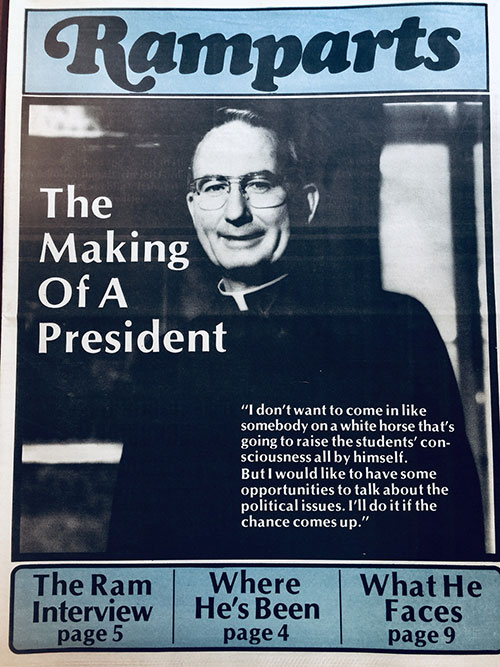
While researching his background, we learned he was tagged at America with the nickname “Joe Cool.” We learned why during the interview. No query caused him to flinch, even when we challenged him about divesting holdings from South Africa or about the university declining to recognize the student group Fordham Lesbians and Gays. (He pledged to combat discrimination, but hedged at official approval. Today, Fordham hosts two student groups, the Pride Alliance and the Rainbow Alliance, as well as the Rainbow Rams alumni chapter).
He invited us to gaze into his crystal ball, citing a need to invest in the Rose Hill library (“We really have to do something about it”). It was a promise fulfilled with the debut of the William D. Walsh Family Library 13 years later, a fitting legacy for this man of words.
The conversation continued after the notebooks closed, but Father O’Hare took over asking the questions. An outdoor modern art installation on campus faced hostility from students, and he invited our opinion. He expressed appreciation for our insights. I appreciated being heard.
Lessons that day—and in ones to follow—linger as a master class in the art of rhetoric, of candor, of transparency.
Father O’Hare told us he hoped to be at the helm for at least seven years. He stayed for 19, the longest tenure in the university’s 179 years.
“The trick is to make Fordham [be] perceived as a national institution but keep the character that is distinctly New York,” he said in framing his vision.
He pulled off the trick. That’s not just an opinion.
—John Breunig, FCRH ’85, is the editorial page editor and a columnist for The Stamford Advocate and Greenwich Time.
]]>The film “MASK,” produced by Yang Xu, FCLC ’21, and Mengxuan Annie Du, FCLC ’20, portrays a private phone call between an Asian mother and daughter who live on opposite sides of the world. In their conversation, they ruminate on the coronavirus-related racism and xenophobia that many people have been experiencing.
“The film speaks to the racial prejudice so many Asians are experiencing in real life, and it does so in such an intimate and personal way,” said Jacqueline Reich, Ph.D., professor and chair of the department of communication and media studies.
Xu and Du’s film won “Best Drama” in Fordham’s inaugural One-Minute Film Festival, a student competition sponsored by the Department of Communication and Media Studies and Fordham’s chapter of the New York Film and Television Student Alliance. Their film was among six award-winning videos that were screened at the Story 2020 Summit on March 7. The all-day summit at the Lincoln Center campus featured panels and Q&A sessions with leading entertainment industry professionals.
“It was an accomplished film that showed real storytelling talent as well as a passion for speaking out against social injustice,” said screenwriter James Jennewein, a senior lecturer in Fordham’s communication and media studies department who helped spearhead the conference. “At times like these, we must be more vigilant about racial and ethnic bias than ever.”
]]>The International Symposium on Digital Scholarship took place from June 3 to 5 at Birkbeck College and Fordham’s London Centre. Sponsored by the University’s Office of Research, it featured a mix of lectures, workshops, and formal and informal gatherings geared toward furthering research opportunities and international collaborations.
If last year’s gathering illustrated how cross-border collaboration is key to tackling vexing challenges of our time, the London gathering showed how, in the digital realm, no one discipline can go it alone.
Bringing Technology and Scholarship Together
“Digital scholarship is notable for its interdisciplinary nature, since it involves not only IT and computer science, but also the humanities, social sciences, and schools of education,” said Maryanne Kowaleski, Ph.D., the academic coordinator for the digital symposium.
The Joseph Fitzpatrick S.J. Distinguished Professor of History and Medieval Studies and curator of Fordham’s Medieval Sources Bibliography, Kowaleski has deep connections to both London and the digital humanities.
In London, she delivered a keynote address, “Giving Credit Where Credit is Due: Acknowledging Collaborative Work in Digital Scholarship Projects.” She also presented a research project that touches on both London and the digital realm, titled “Prosopography, Database Design, and Linked Data in the Medieval Londoners Project.”
The project is a collaboration with Katherina Fostano, visual resources coordinator in the department of Art History, and Kowaleski said it was notable that Fostano presented at the conference, as did Elizabeth Cornell, Ph.D., director of communications at Fordham’s department of information technology. Adding professional staff such as librarians and graduate students to the mix, was key to the conference’s success, she said.
“One of the things that my research shows, and that I have experienced, is how crucial librarians are to digital efforts now. I’m grateful that Fordham has included them in this program,” she said.
London and New York, Working as a Team
Representing the Graduate School of Education (GSE), Professor of Childhood Special Education Su-Je Cho, Ph.D, and doctoral student Kathleen Doyle jointly presented “Using a Digital Learning Platform to Increase Levels of Evidence-Based Practices in Global Teacher Education Programs.” It detailed Project REACH, a U.S. Department of Education-funded initiative that makes widely available the best evidence-based practices for training prospective teachers.
George Magoulas, Ph.D., Alex Poulovassilis, Ph.D., and Andrea Cali, Ph.D., members of Birkbeck College’s Knowledge Lab, helped them collect and analyze data through the website.
Working with a partner in London made sense for this project, Cho said, because one of her goals is for Project REACH to get more use internationally. She, Doyle, and the GSE’s Alesia Moldavan, Ph.D., assistant professor of mathematics education, will collaborate with Christine Edwards-Leis, Ph.D., associate dean of research, and enterprise and doctoral student Jennifer Murray from St. Mary’s College in London on a new endeavor geared toward student teachers’ mental health. Once finished, it will be incorporated into Project REACH.
“The student teaching experience is very stressful, because it’s not their own classroom they have to student teach in. It’s someone else’s classroom. By providing this kind of platform, they can also share their concerns and knowledge and frustrations with the students overseas,” she said.
For Doyle, the trip was an opportunity to see how colleagues from other disciplines assemble collaborative teams.
“I really appreciated learning across the fields. Being in the Graduate School of Education, I’ve been mainly focused on that field. It was refreshing to hear about the other ways digital scholarship is utilized in other disciplines,” she said.
Urban Challenges That Cross Borders
Gregory T. Donovan, Ph.D., assistant professor of communication and media studies, presented “Keeping Place in ‘Smart’ Cities: Situating the Settlement House as a Means of Knowing and Belonging in the Informational City.” The project, which he is developing with the assistance of Melissa Butcher, Ph.D., reader in social and cultural geography at Birkbeck College, will highlight the efforts of New York City’s Lincoln Square Neighborhood Center and London’s Toynbee Hall.
The project will focus on the “settlement house” model of community center that was founded a century ago to confront segregation and displacement and promote belonging.
“New York City and London are examples of global cities that are going through significant technological change, both in terms of the cities themselves becoming more digitized as well as the economy and the kinds of jobs and the kinds of education that’s being elevated. With that comes all kinds of difficult changes and gentrification that causes displacement,” said Donovan, who is also organizing November symposium at Fordham called Mapping (in)justice.
“We’re going to look at how we might network [Lincoln Square and Toynbee] through digital technology and think about how they’re managing to keep pace in these communities that are often being displaced in this kind of digital gentrification.”
]]>